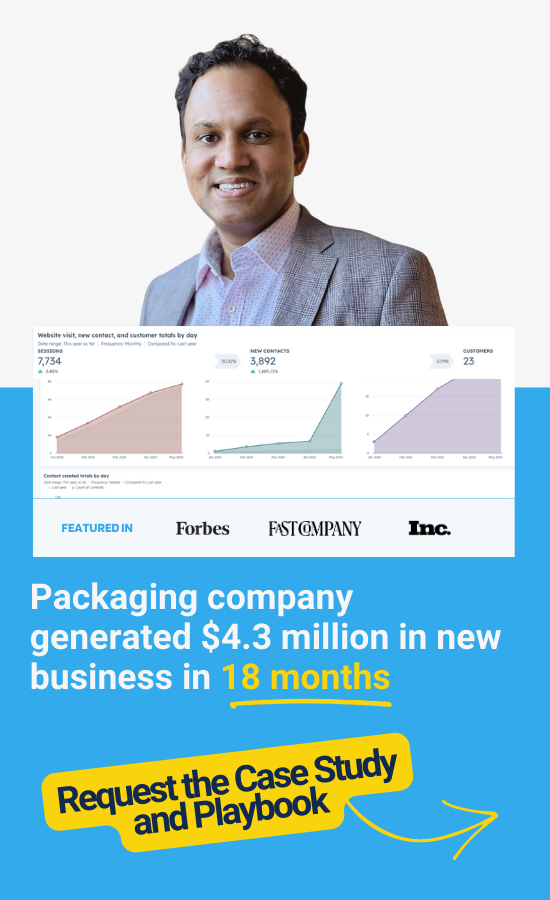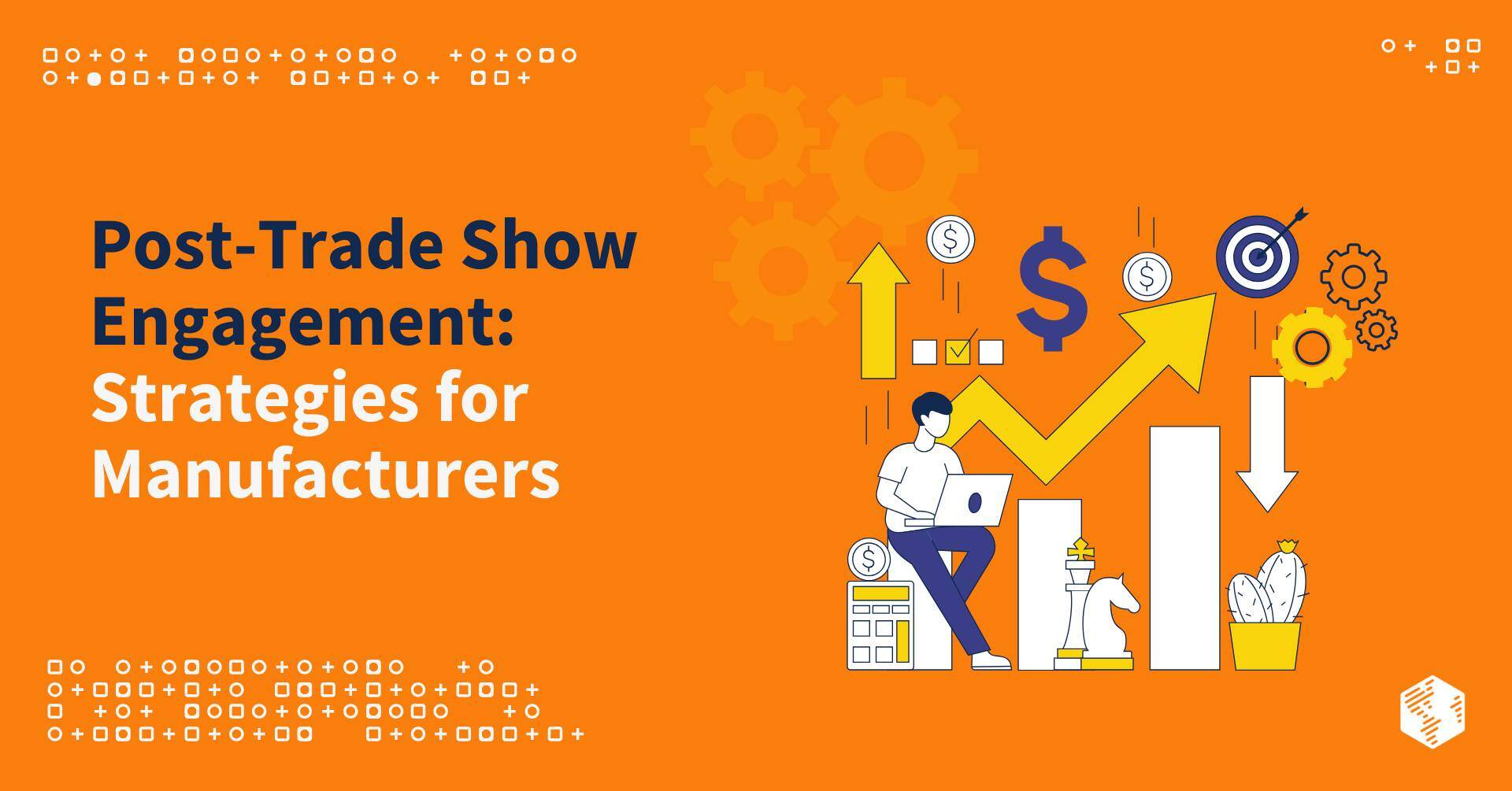Table Of Contents
Trade shows are a prime opportunity for manufacturing companies to showcase their products, meet potential clients, and gather leads. However, the real work begins after the event. Engaging with your leads post-trade show is crucial to converting them into customers.
Effective post-trade show engagement involves prompt follow-up, personalized communication, multi-channel outreach, and valuable content sharing. The use of CRM platforms like HubSpot will help you capture and manage leads as well as streamline your process and enhance results.
How to Effectively Track Trade Show Success
Active engagement after a trade show is essential for converting potential leads into loyal customers. By implementing a range of follow-up tactics, you can maintain and strengthen the valuable connections made during the event. Here’s how you can effectively follow up and sustain relationships with your trade show leads:
1. Prompt Follow-Up
The first step to successful post-trade show engagement is a prompt follow-up. Send a trade show follow-up email within 24-48 hours after the event. Mention specifics from your conversation to make the email personal. This shows your leads that you value the connection and are eager to continue the conversation.
2. Personalized Communication
Personalize your communication based on the interactions you had during the trade show. Use the information you gathered to tailor your emails. For instance, if a lead showed interest in a specific product, highlight how it can benefit their operations in your follow-up email. Personalized emails have a higher chance of being read and responded to.
3. Use Multiple Channels
Don’t rely solely on emails. Use multiple channels to reach out to your leads. Connect with them on LinkedIn, send direct messages, and even consider calling them. This multi-channel approach ensures that your message gets through and keeps your brand fresh in their minds.
4. Provide Valuable Content
Share valuable content that addresses your leads’ pain points and interests. This could be in the form of blog posts, whitepapers, or case studies. For example, a blog post on the benefits of your latest technology or a case study on how your solution improved a client’s production line can be very effective. This not only keeps your leads engaged but also positions your company as an industry expert.
5. Invite to Webinars or Demos
Invite your leads to webinars or product demos. These events offer a more in-depth look at your products and provide an opportunity for leads to ask questions. This interactive approach can significantly boost engagement and move leads further down the sales funnel.
These strategies will help you effectively nurture your trade show leads. Each step helps build stronger connections and demonstrates your commitment to meeting their needs. With consistent follow-up and valuable content, you’ll maximize your trade show success.
How to Streamline Trade Show Lead Capture and Follow-Up with HubSpot
To streamline your engagement efforts, using tools like HubSpot CRM for lead capture and follow-up can make your process even more efficient and effective. Here are some of HubSpot’s most effective tools for lead capture:
| HubSpot Tool | Description |
|---|---|
| HubSpot Forms | Set up HubSpot forms to capture lead information on the spot. You can use tablets or mobile devices at your booth to have attendees fill out their details directly into HubSpot. This ensures immediate entry of accurate information. |
| QR Codes | Create QR codes that link to HubSpot forms. Display these codes at your booth, allowing visitors to scan and submit their information using their smartphones. This method is quick and contactless, appealing to many attendees. |
| Business Card Scanners | Use HubSpot’s mobile app to scan business cards. The app automatically extracts contact details and creates a new contact record in your CRM. This saves time and reduces the risk of losing important information. |
| Custom Properties | Customize properties in HubSpot to capture specific information relevant to the trade show. For example, you can add fields for product interests or meeting notes, ensuring that all critical data is recorded. |
| Offline Mode | Use HubSpot’s offline mode to capture leads even when internet connectivity is limited. Once you’re back online, the data syncs automatically with your CRM. |
How to Use HubSpot for Post-Trade Show Lead Nurturing and Follow-Up
Once you have gathered valuable information from your trade show leads, effective follow-up is crucial. For ongoing engagement, use HubSpot’s CRM and marketing automation tools to set up regular newsletters, drip campaigns, and personalized content delivery. This keeps you in touch with your leads and customers, tracking their engagement and adjusting your strategies based on their behavior. HubSpot’s analytics help you understand what’s working and what needs improvement.
Here’s a breakdown of HubSpot’s tools for following up and nurturing your leads:
1. Automated Email Sequences
Set up automated email sequences in HubSpot to ensure timely follow-up. Create a series of emails that thank attendees for visiting your booth, provide additional information about your products, and invite them to schedule a demo or meeting.
2. Personalization
Use the data captured during the event to personalize your follow-up emails. Mention specific products they showed interest in or reference the conversation you had. Personalized emails have higher open and response rates.
3. Segmentation
Segment your leads based on various criteria such as product interest, engagement level, or company size. This allows you to tailor your follow-up strategy for each group, making your communication more relevant and effective.
4. Lead Scoring
Implement lead scoring in HubSpot to prioritize leads based on their level of interest and engagement. Assign scores to actions like opening emails, clicking links, or visiting your website. Focus your efforts on high-scoring leads for better conversion rates.
5. Workflows
Use HubSpot workflows to automate tasks and reminders for your sales team. For example, create a workflow that assigns follow-up tasks to sales reps based on lead behavior, ensuring no lead falls through the cracks.
6. Dashboards and Reporting
Track the progress of your follow-up efforts using HubSpot’s dashboards and reporting tools. Monitor metrics such as email open rates, click-through rates, and lead conversion rates. Use this data to optimize your follow-up strategy and improve ROI.
7. Integration with Sales Tools
Integrate HubSpot with other sales tools you use, such as calendar apps for scheduling meetings or CRM systems for managing customer relationships. This ensures a seamless follow-up process and better lead management.
HubSpot CRM gathers and tracks leads at trade shows guaranteeing effective lead management and nurturing. The tools provided simplify the process, tailor communication, and improve strategies for engaging with leads.
Maintaining Post Trade Show Engagement with HubSpot
In addition to lead nurturing and follow-up, HubSpot offers a comprehensive set of tools to facilitate ongoing customer engagement. Many of these features overlap with the ones discussed earlier, supporting multiple goals and strategies. Key features include:
| HubSpot Tool | Description |
|---|---|
| Segmentation and Personalization | Use HubSpot to segment your customers based on their interests, behaviors, and past interactions. This allows you to send personalized content that resonates with them. Personalized communication makes customers feel valued and keeps them engaged. |
| Automated Workflows | Set up automated workflows in HubSpot to maintain regular contact with your customers. Create a series of emails that provide updates, share valuable content, and offer special deals. Automation ensures consistent engagement without overwhelming your team. |
| Customer Surveys | Use HubSpot to send out customer satisfaction surveys after events. Collecting and analyzing feedback helps you understand what your customers value and how you can improve their experience. |
| Content Sharing | Regularly share valuable content through HubSpot. This could include industry news, how-to guides, product updates, and case studies. Providing ongoing value keeps your customers engaged and informed. |
| Event Follow-Up | After an event, use HubSpot to follow up with attendees. Send personalized thank-you emails, share event highlights, and offer exclusive post-event content. This reinforces the connection and keeps your brand top-of-mind. |
| Loyalty Programs | Implement loyalty programs through HubSpot. Track customer interactions and reward them for their engagement. Loyalty programs incentivize ongoing interaction and strengthen customer relationships. |
| Custom Dashboards and Reporting | Use HubSpot’s dashboards and reporting tools to monitor customer engagement metrics. Track email open rates, click-through rates, and other key performance indicators. Use these insights to refine your engagement strategies. |
| Integration with CRM | Integrate HubSpot with your CRM to ensure a seamless flow of information. This integration helps you maintain a complete view of your customer interactions, making it easier to personalize your engagement efforts. |
Beyond initial follow-ups, HubSpot offers powerful tools to keep your audience engaged and connected. Let’s dive into how you can use HubSpot to maintain and strengthen these relationships long after the trade show has ended.
Now that we’ve explored how to maintain post-trade show engagement using HubSpot, it’s important to understand the broader impact of event marketing. Let’s look at the benefits event marketing brings to manufacturers and how it can drive long-term success.
What Are the Benefits of Event Marketing for Manufacturers?
Event marketing isn’t just about acquiring new leads; it’s also a powerful tool for strengthening relationships with existing customers. For manufacturing companies, staying connected with your current customers is crucial for long-term success. Here’s how event marketing can help retain customers:
- Strengthen Relationships: Events provide a unique opportunity to interact with your customers face-to-face. These interactions help build stronger relationships, fostering loyalty and trust.
- Customer Appreciation: Hosting exclusive events for your customers shows them that you value their business. Whether it’s a VIP dinner, a product launch, or a customer appreciation day, these events make your customers feel special and appreciated.
- Showcase Innovations: Use events to showcase your latest products and innovations. Keeping your customers informed about new developments ensures they see the ongoing value in your partnership.
- Gather Feedback: Events are a great platform to gather feedback directly from your customers. Understanding their needs and pain points helps you improve your products and services, enhancing customer satisfaction and retention.
- Create Community: Events create a sense of community among your customers. When they feel part of a larger network, they are more likely to stay engaged with your brand.
Event marketing is vital for enhancing customer relationships and creating opportunities for direct feedback. Trade show events foster a sense of community and appreciation among your customers.

Turning Trade Show Leads into Loyal Customers
Post-trade show engagement is your opportunity to turn casual conversations into long-term partnerships. By integrating tools like HubSpot and focusing on personalized, multi-channel follow-ups, you can maintain the momentum you gain from all the hard work you put into each event.
Regularly evaluating your strategies and making data-driven adjustments will keep your approach fresh and effective. Stay proactive and attentive to your leads’ needs, and you’ll see your trade show efforts pay off.
For custom advice on optimizing your post-trade show strategies, schedule a consultation with the OneIMS team today. Our experts are here to help you turn leads into loyal customers.






